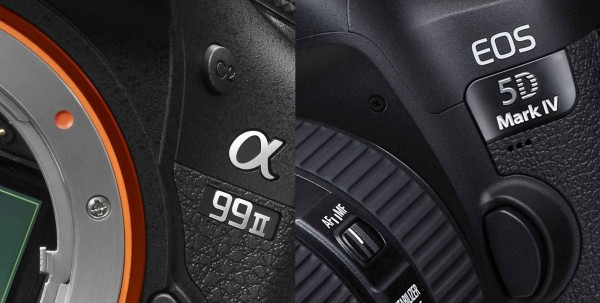
Full-frame cameras are expensive beasts, designed specifically to please the professional market. Of course those with a bigger wallet will find plenty to enjoy as well but at its core, cameras like the Sony a99 II are designed to give pros every tool under the sun. So how does the latest full-frame Sony compare to the entrenched Canon? Matt Golowczynski writes this for digitalrev:
Canon’s EOS 5D Mark IV is a considerable jump over its mark III predecessor, with a fresh sensor, 4K video and a revamped AF system heading a long list of changes. The same, however, could be said for Sony’s A99 II, which appears to target a very similar user. So, when you look at the main specs, how do they compare?
Though remarkable hardware has almost always been a given for Sony, one of the problems they’ve faced in the past with their cameras has been button placement. This is a problem that even plagued their compact camera lineup where awkward placement for features like ‘record’ at times meant you’d trigger unwarranted actions with your camera. With that as the backdrop,
Sony’s design has slightly larger buttons, however, and with the power control around the shutter-release button, you can conveniently turn the camera on and take an image using just one hand, which is useful for more spontaneous captures. On the EOS 5D Mark IV the power control is on the other side of the top plate, behind the mode dial, which is only really practical to thumb with the left hand.
The A99 II’s grip is more defined and sculpted than the relatively flat grip on the EOS 5D Mark IV. The latter is perhaps a safer option with regards to pleasing many different users with differently sized hands, although some people will no doubt prefer the way in which the A99 II’s grip allows for their fingers fit around it.
Now chances are that button placement and grip won’t necessarily convince you to ditch one camera for another but you know what will? Image quality.
Both cameras use full-frame sensors, with Canon’s offering 30.4MP and Sony’s upping this to 42.4MP. Sony’s sensor is also based on a back-illuminated construction for better light-gathering capabilities, and the fact that’s been designed without an optical low-pass filter makes it even more capable of recording finer detail, though potentially at the expense of aliasing artefacts.
Although both cameras work with image-stabilised lenses, the A99 II has image stabilisation built into it too. This allows for correction over five axes and has the advantage of working an exhaustive range of unstabilised lenses.
Normally on such a model, lens-based IS systems have the advantage of showing the stabilisation effect through the viewfinder, which is a great help when composing images. However, the fact that the A99 II employs an EVF rather than an optical viewfinder means that it can show this too, regardless of whether stabilisation occurs in the lens or at the sensor.
I’m firmly of the mindset that we’ve reached the peak of what megapixels can offer us and that the size of the pixels are far more important than increased pixel count. But what can make the difference between getting that ‘oh so perfect shot’ and missing it is IS, something that Sony has long been a proponent of offering via their cameras. This in my book is one of the single most important design decisions that gives Sony a clear advantage over its peers – but that’s not the only thing that sets the two cameras apart.
The A99 II’s 12fps burst mode also trounces the EOS 5D Mark IV 7fps option, although 7fps is perfectly respectable for a model with such a sensor.
Respectable of course doesn’t win the race, nor does it help capture that one brilliant moment. Unsurprisingly, Sony and Canon had different visions for 4K.
First, while the A99 II records 4K UHD (3840×2160) footage, the EOS 5D Mark IV opts for DCI 4K (4096×2160) footage, which has a slightly wider aspect ratio.
Another difference is that 4K footage on the EOS 5D Mark IV is subject to a 1.74x crop factor, which makes it harder to shoot with wide angles. The A99 II meanwhile, does not apply crop factor as standard, although it can be set to a Super 35mm crop mode if desired.
Ultimately Matt wraps up with:
The A99 II does have a number of advantages, however, that should see it win over those not tied to any system. From its sensor and built-in image stabilisation to its faster burst rate and more densely populated AF system, and with a more flexible video option on top of all this, the camera is likely to appeal to a particularly broad range of different users.
One of the biggest challenges Sony will always face is getting people who’ve been shooting for years, if not decades, with a Canon or Nikon to convert. It seems fairly conclusive now that Sony cameras have reached a point where they outpace their peers, putting the technological argument to an end.
Instead where Sony needs to focus on is mindshare, which I believe is a two tier approach. One – convince and target traditionalist who immediately assume the old guards still hold the key to great photography to give their cameras a try and two – ensure that Sony is front and center to the new generation of photographers that are just coming out of high school and college with little baggage or loyalty to a brand, and inspire them to start off with a Sony.
For those wanting to know the nuances between the two cameras, they should read the full comparison by Matt.

You must be logged in to post a comment.